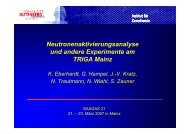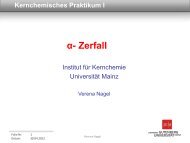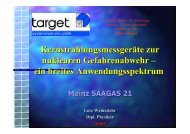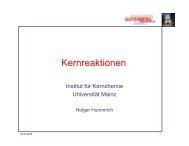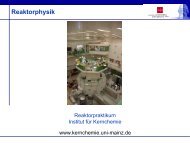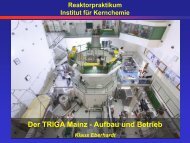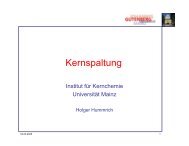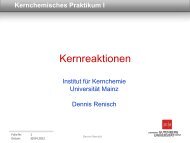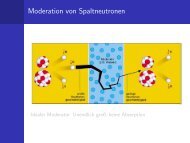jahresbericht 2007 - Institut für Kernchemie - Johannes Gutenberg ...
jahresbericht 2007 - Institut für Kernchemie - Johannes Gutenberg ...
jahresbericht 2007 - Institut für Kernchemie - Johannes Gutenberg ...
You also want an ePaper? Increase the reach of your titles
YUMPU automatically turns print PDFs into web optimized ePapers that Google loves.
Further Developments on the CE-DAD-ICP-MS Coupling for the Investigation of<br />
the Lantahnides/Actinides-Humic Substances Complexation<br />
R. A. Buda 1 , J. V. Kratz 1 , D. Kutscher 1,2<br />
1. <strong>Institut</strong> für <strong>Kernchemie</strong>, <strong>Johannes</strong> <strong>Gutenberg</strong>-Universität Mainz, Germany<br />
2. Departamento de Quimica Física y Analítica, Universidad de Oviedo, Oviedo, Spain<br />
ICP-MS – MS Data Intensity [cps]<br />
[cps]<br />
In earlier studies [1], it has been shown that<br />
the CE-DAD-ICP-MS (capillary electrophoresis<br />
diode array detector ICP-MS) coupling can be<br />
applied for the investigation of the<br />
complexation of metal ions with humic<br />
substances. The separation of the different<br />
species was performed in the CE and the<br />
species were identified using the two<br />
detectors. Fig. 1 presents a typical<br />
electropherogram obtained for the separation<br />
of a solution containing iodine marked Aldrich<br />
humic acid (AHA) and Ho. The humate<br />
complexation of Ho and separation took place<br />
in 0.1 M NaClO 4 . 1 M AcOH was used as a<br />
buffer for the CE. The interpretation of the<br />
electro-pherogram obtained by ICP-MS (lower<br />
part of Fig.1) is rather complicated without the<br />
help of the second detector. After applying the<br />
necessary time correction for the two<br />
electropherograms, a firm assignment of the<br />
signals could be done, as depicted in Fig.1.<br />
0 25 50 75 100 125 150 175 200 225 250 275 300<br />
150000<br />
125000<br />
100000<br />
75000<br />
50000<br />
25000<br />
Free iodine<br />
DAD Time [s]<br />
DAD Data Time [s]<br />
I<br />
Ho<br />
-10<br />
-20<br />
0<br />
-30<br />
0 50 100 150 200 250 300 350 400<br />
ICP – MS Time [s]<br />
ICP-MS Data Time [s]<br />
Free Ho ions<br />
200 nm<br />
235 nm<br />
30<br />
DAD<br />
20<br />
ICP-MS<br />
EOF<br />
Ho released from complex<br />
Ho humate with iodine marked humic acid<br />
10<br />
0<br />
DAD Absorption [a.u.]<br />
DAD Data Absorbtion [a.u.]<br />
Figure 1: Separation of a solution containing Ho and<br />
iodine marked AHA, by CE-DAD-ICP-MS<br />
Iodine was used for marking the AHA, because<br />
it can be easily detected by both detectors,<br />
facilitating the identification of the species. It<br />
can be seen that a big part of the iodine was<br />
removed from the AHA during, or before the<br />
separation. It is not clear whether the presence<br />
of iodine influences the complexation of<br />
actinides with humic substances, thus the<br />
iodine marked AHA was used only for<br />
calibration. In the peak marked in brown,<br />
besides the iodine detected by DAD and ICP-<br />
MS a peak is detected by ICP-MS on the mass<br />
of Ho, and a third DAD peak is noticed at 235<br />
nm, a characteristic AHA absorption<br />
wavelength. Thus, this signal has been<br />
assigned to metal-humate complex. A<br />
significant tailing can be observed in the ICP-<br />
MS electropherogram on the mass of Ho. This<br />
has been assigned to the metal ion species<br />
which are dissociated from the metal ion<br />
humate complexes during the separation. It is<br />
supposed that these are dissociated from the<br />
“weak binding sites” of the humic acid. These<br />
species carry lower negative charges than the<br />
Ho-AHA complexes, and become gradually<br />
positively charged, as confirmed by the<br />
presence of the EOF in the middle of the<br />
tailing. The EOF was identified with the help of<br />
the DAD and is marked red in Fig. 1. The last<br />
ascending part of the tailing is associated to<br />
the positively charged free metal ions.<br />
It can be observed in Fig. 1 that it is rather<br />
difficult to make an accurate separation of the<br />
species due to the tailing of the Ho<br />
electropherogram detected by ICP-MS. The<br />
complexation constants that were determined<br />
at concentrations of metal ion varying between<br />
0.21 – 2.01 ppm were systematically too low<br />
as compared to values in the literature [2].<br />
Using the actual setup we were not able to<br />
work with lower concentrations of metal ion. By<br />
employing a new coupling technique, i.e. the<br />
MiraMist CE, it is expected to reduce the<br />
detection limits of the technique. At lower<br />
concentrations of metal ion, the complexation<br />
at the “weak binding sites” is less likely to take<br />
place, allowing thus a more precise<br />
determination of the complexation constants of<br />
humic substances with metal ions. The first<br />
test experiments with a MiraMist CE nebulizer<br />
(total consumption nebulizer) have already<br />
been performed [3].<br />
References:<br />
[1] D. Kutscher et al.: Annual Report, <strong>Institut</strong> für<br />
<strong>Kernchemie</strong>, Universität Mainz, C 17, (2006)<br />
[2] D. Kutscher: Diploma Thesis, <strong>Institut</strong> für<br />
<strong>Kernchemie</strong>, Universität Mainz, (<strong>2007</strong>)<br />
[3] Th. Wunderlich et al.: Annual Report, <strong>Institut</strong> für<br />
<strong>Kernchemie</strong>, Universität Mainz, this issue, (<strong>2007</strong>)<br />
- C8 -



